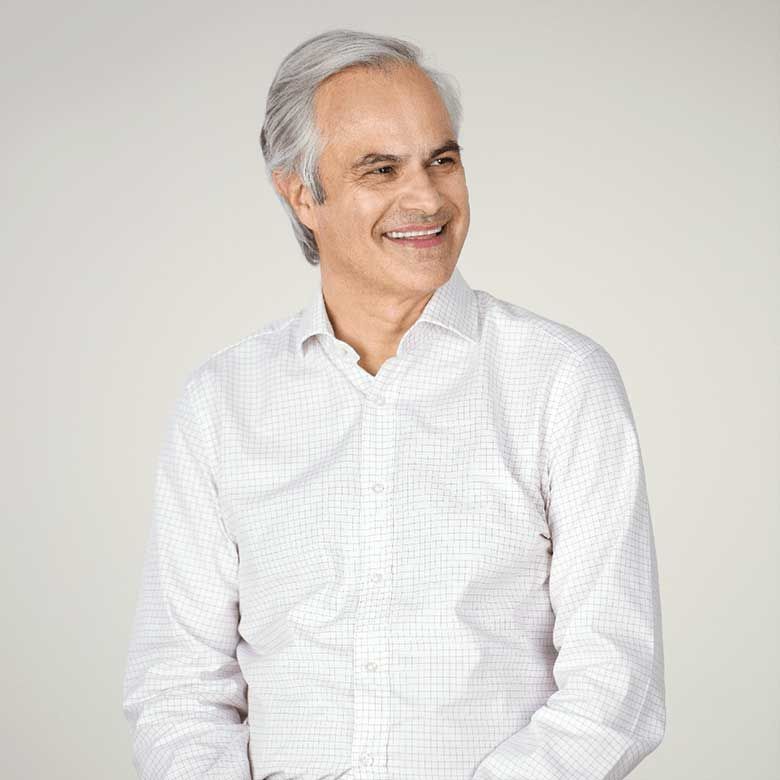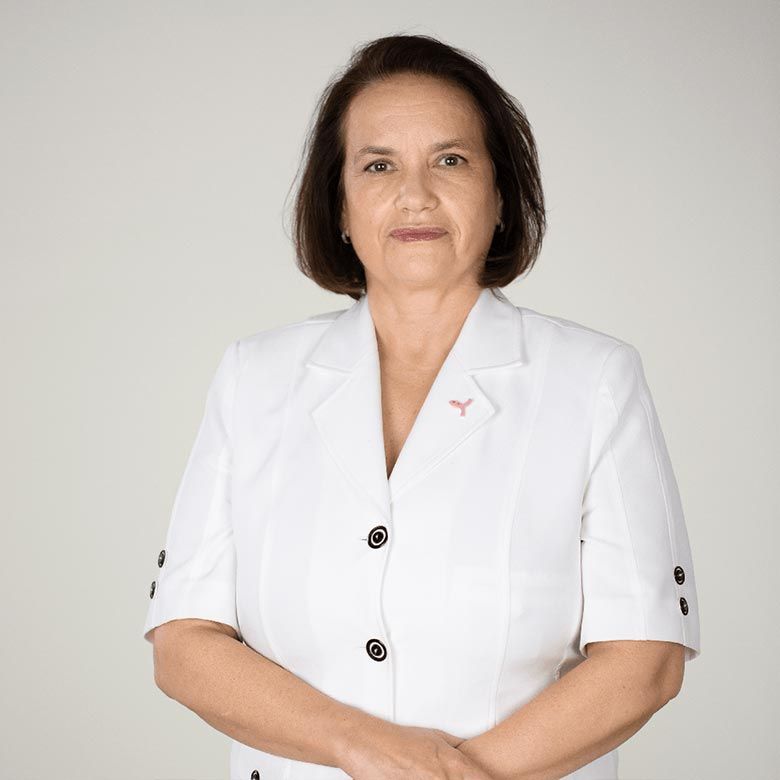
What is breast cancer?
What is breast cancer?

Breast cancer, or mammary carcinoma, is a malignant growth (carcinoma) occurring mainly in the breast (mamma) of women. Breast cancer is associated with changes in the breast tissue that lead to the formation of one or more malignant tumours.1
Breast cancer is the most common cancer in women. It accounts for approximately 5,400 new cases per year and 30% of all tumours in Austria. One out of eight women will develop breast cancer at some point in her life.2
The incidence of breast cancer depends mainly on age. The table below gives an overview of how many women out of 1,000 develop breast cancer:16,17
| Age 20 to 24 / 0.01 women // | Age 55 to 59 / 2.22 women ** |
| Age 25 to 29 / 0.08 women // | Age 60 to 64 / 2.94 women ** |
| Age 30 to 34 / 0.25 women // | Age 65 to 69 / 3.74 women ** |
| Age 35 to 39 / 0.58 women // | Age 70 to 74 / 3.91 women ** |
| Age 40 to 44/ 1.16 women // | Age 75 to 79 / 3.65 women ** |
| Age 45 to 49 / 1.83 women ** | Age 80 to 84 / 3.64 women ** |
| Age 50 to 54 / 2.20 women ** | Age 85 and above / 3.17 women ** |
// European Society of Breast Cancer Specialists (EUSOMA)
** Federal Statistical Office, Switzerland
How does cancer develop?
How does cancer develop?

When healthy cells in the body begin to change their behavior, cancer can develop - changes in genetic information are usually the cause. Cancer cells start to grow uncontrollably and displace healthy tissue. They often migrate from their place of origin and continue to grow in another part of the body, where they form metastases.4
Interesting fact: Breast cancer is more common in the left than the right breast. However, further research is required to find out why this is the case.5
In about five to ten percent of cases, changes in the genetic information (i.e. mutations) act as triggers for breast cancer. These changes most commonly occur in one of the two “breast cancer related genes”, BRCA1 and BRCA2. If breast cancer occurs frequently within a family or at a young age, this may indicate the presence of an inherited form of breast cancer. Throughout Austria, specially trained doctors can help you estimate your personal risk of developing breast cancer and clarify potential causes with genetic tests (see here, for further information)*.6
How can I detect symptoms?
How can I detect symptoms?

Because breast cancer usually does not cause any pain in its early stages, it is even more important to watch out for the following symptoms :4, 5, 7, 8, 18
- Any changes in the size or shape of the breast
- Visible retractions, folds, or bumps
- Redness or irritation of the breast tissue
- Areas of thickened or hardened breast tissue
- Retracted nipples or nipple discharge
- Pain in the breast
- Palpable swelling or lumps in your armpit
If you notice any of these symptoms please consult your doctor.
Important to know: Not every lump or change in your breast means that you have cancer. Many changes are harmless or result from conditions other than cancer.
How is breast cancer diagnosed?
How is breast cancer diagnosed?

The most common diagnostic method for an early detection of breast cancer is a mammography. It involves taking X-rays of your breast in different projections and enables the detection of breast cancer in early stages, thereby allowing the use of less aggressive treatments and preventing deaths. False positives and the use of radiation are often listed as disadvantages of this technique. In rare cases, mammography findings may be inconspicuous although breast cancer is already present in the patient's body.9
Normally the earlier breast cancer is detected, the better is the outcome. In Austria, women between the ages of 45 and 69 years are encouraged to schedule a mammography every two years – at no cost (find out more)*.10
If the mammography result is inconclusive, the breast is visualised by ultrasound. This is referred to as mammary sonography.9
A biopsy involves taking a sample of tumour tissue from your breast to be tested in the lab in order to determine whether the breast change is benign or malignant. It also allows determination of the hormone receptor status and HER2 status. The test results will provide important information regarding the choice of treatment.11
How is breast cancer treated?
How is breast cancer treated?

Once the diagnosis is made, the medical team will decide together with the patient how to proceed. There is usually no urgent need for action. This means that sufficient time is available to collect information, consider the options, and obtain a second opinion if necessary.13
One encouraging fact is that considerable therapeutic advances have led to an overall decline in death rates in developed countries such as Sweden, Japan, the US and Austria. These countries currently have survival rates of 80% or more. Developing counties have survival rates of less than 40%.2, 12
Therapeutic decisions are driven by various factors, including the tumour stage. The classification of a tumour is based on the TNM criteria: primary tumor (T), regional lymph nodes (N), and distant metastases (M).13 These criteria also enable doctors to classify tumours into either an early stage or a late stage 19
The tumour type – i.e. the specific features of the tumour – greatly influences the therapeutic choices. One out of five patients over-produce a specific type of protein called HER2. Doctors refer to this as HER2-positive breast cancer. Two thirds of all breast cancers produce abnormal amounts of receptors for the hormones, estrogen and/or progesterone. This is referred to as hormone receptor-positive breast cancer.13
Other factors influencing the treatment plan are the current health status and the age of the patient as well as the hormone receptor and HER2 status. It is also relevant whether this is an initial disease manifestation or a recurrent one (relapse).13
There are three therapeutic pillars available for treating breast cancer: surgery, pharmaceutical therapy, and radiotherapy.13
One novel approach is cancer immunotherapy, which is among the most promising strategies for treating cancer. The objective is to activate the body’s immune system to successfully recognise, attack, and destroy cancer cells. After decades of research, there is good reason to hope that this treatment will be able to achieve a long term stabilisation for patients with certain types of cancer.14 (Read more)*
Breast cancer, or mammary carcinoma, is a malignant growth (carcinoma) occurring mainly in the breast (mamma) of women. Breast cancer is associated with changes in the breast tissue that lead to the formation of one or more malignant tumours.1
Breast cancer is the most common cancer in women. It accounts for approximately 5,400 new cases per year and 30% of all tumours in Austria. One out of eight women will develop breast cancer at some point in her life.2
How to

If you notice any of these warning signs, tell your doctor!
Breast self-examinations are a pretty controversial topic among medical professionals.
Advocates of breast self-examinations say that they can help women gain awareness of their bodies. However, critics argue that breast self-examinations lead to a high level of false positive results, especially in young women, who may develop changes and lumps during their monthly menstrual cycle. Self-breast examinations alone might not be sufficient to detect cancers early enough to reduce mortality. It is best to talk to your doctor about the advantages and disadvantages of self-examining your breasts to get a better sense of what is right for you.
If you have decided to perform breast self-examinations, just follow these six simple steps.
Please note that breast-self examinations are not a substitute for regular examinations from your doctor!7, 15
Take a look
Our Roche #watchyourboobs movement intends to raise awareness for the critical and sensitive topic that is breast cancer. Open your eyes and #watchyourboobs!
We want to break the taboo to talk about breast cancer. Today this disease is not a death sentence anymore. There is hope in the fight against breast cancer and we at Roche are by your side researching for cures to tackle this disease.
The aim of our hand-drawn #watchyourboobs illustrations is to encourage everyone to be part of this movement and to literally watch your boobs!












Become a boob ambassador!
Be part of the movement and spread the word: post a selfie while using the #watchyourboobs filter to raise awareness for breast health together with thousands of others. Let’s bring the movement in motion!
Medical experts
We are grateful for the support of health care professionals from various specialties. Together, we are working towards the shared goal of improving breast health. – #watchyourboobs.

UNIV. PROF. DR. CHRISTIAN SINGER, GYNECOLOGIST

UNIV. PROF. DR. ALEXANDRA RESCH, RADIOLOGIST







